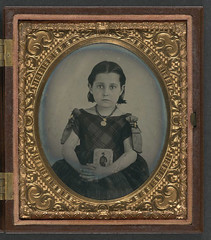Difference between revisions of "Ambrotype"
m (fixed two broken img, +headers) |
(*Think* melainotype is ferrotype, on metal not glass. Commented out a few words.) |
||
| Line 6: | Line 6: | ||
|colspan=3|Abraham Lincoln, Union soldier, girl with image of her father, images: Library of Congress {{public domain}} | |colspan=3|Abraham Lincoln, Union soldier, girl with image of her father, images: Library of Congress {{public domain}} | ||
|} | |} | ||
| − | '''Ambrotype''' is a [[:Category:Photographic processes|photographic process]] resulting in positives on glass, originated by [[Frederick Scott Archer]] and Peter W Fry in 1851<ref>''Focal Encyclopedia of Photography'', Focal Press, 1976 edition, p.40</ref>. It was intended as a cheaper alternative to the [[Daguerreotype Process|Daguerreotype]]. It is based on the [[wet-collodion ]]process. It was also known, in Britain, as "''collodion positive''", and in other places as "''Melainotype''". | + | '''Ambrotype''' is a [[:Category:Photographic processes|photographic process]] resulting in positives on glass, originated by [[Frederick Scott Archer]] and Peter W Fry in 1851<ref>''Focal Encyclopedia of Photography'', Focal Press, 1976 edition, p.40</ref>. It was intended as a cheaper alternative to the [[Daguerreotype Process|Daguerreotype]]. It is based on the [[wet-collodion ]]process. It was also known, in Britain, as "''collodion positive''"<!--, and in other places as "''Melainotype''" commenting this out; all sources I can find say melainotype is what was later called ferrotype/tintype, on a metal base-->. |
Glass plates are prepared, and developed as in the [[wet-collodion]] process, but underexposed. This gives a less dark glass negative. The negative is treated with mercuric bichloride to whiten the exposed areas. The plate is mounted in a metal frame with a black background. The background makes the negative appear positive - as the whitened silvered areas reflect light, and the transparent areas show the black background. | Glass plates are prepared, and developed as in the [[wet-collodion]] process, but underexposed. This gives a less dark glass negative. The negative is treated with mercuric bichloride to whiten the exposed areas. The plate is mounted in a metal frame with a black background. The background makes the negative appear positive - as the whitened silvered areas reflect light, and the transparent areas show the black background. | ||
Revision as of 16:04, 15 October 2020

|

|

|
| Abraham Lincoln, Union soldier, girl with image of her father, images: Library of Congress (Image rights) | ||
Ambrotype is a photographic process resulting in positives on glass, originated by Frederick Scott Archer and Peter W Fry in 1851[1]. It was intended as a cheaper alternative to the Daguerreotype. It is based on the wet-collodion process. It was also known, in Britain, as "collodion positive".
Glass plates are prepared, and developed as in the wet-collodion process, but underexposed. This gives a less dark glass negative. The negative is treated with mercuric bichloride to whiten the exposed areas. The plate is mounted in a metal frame with a black background. The background makes the negative appear positive - as the whitened silvered areas reflect light, and the transparent areas show the black background.
The back was sometimes varnished or coated with balsam to improve the image; James Ambrose Cutting of Boston was granted a US patent in 1854[2] on a method of doing this - which makes the image "greatly increased in strength and beauty by imparting additional brilliancy".
Ambrotypes were often hand-tinted to increase the contrast; without this, Ambrotypes are grayish-white and compare poorly to Daguerreotypes.
Notes
- ↑ Focal Encyclopedia of Photography, Focal Press, 1976 edition, p.40
- ↑ US Patent 11,267: Improvement in Photographic Pictures on Glass
Links
- Wikipedia: Ambrotype - apparently wrongly attributes the invention to Cutting, whose patent only mentions the varnish or balsam back coating.